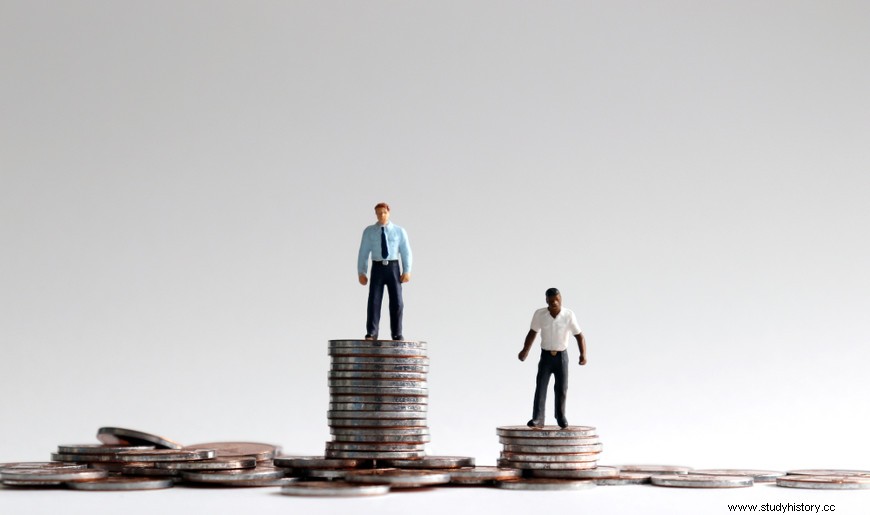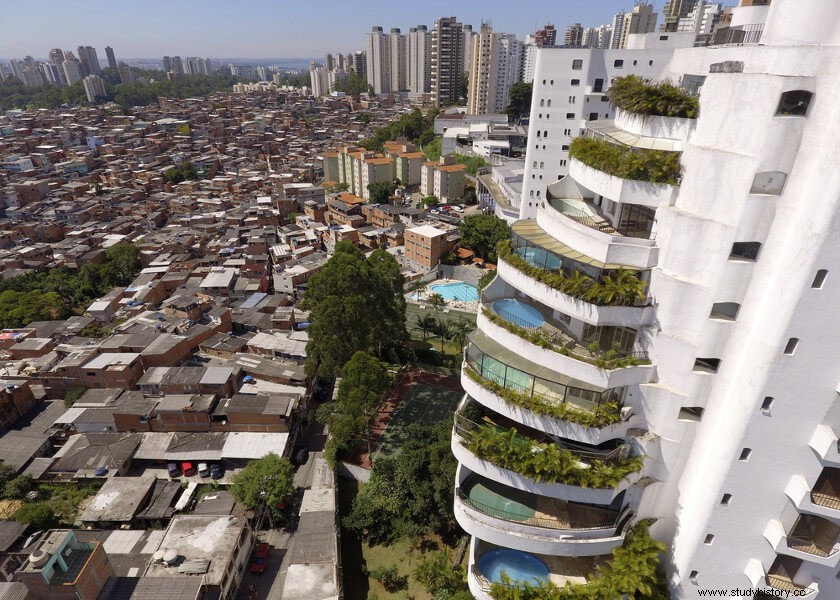
The term social inequality It is a sociological and economic concept that designates the difference between social classes. Inequality can be measured by the income brackets compared (there is a method of comparing the averages of the richest income brackets with the poorest income brackets). The result of this comparison can be put into a formula developed by the Italian economist and statistician Corrado Gini, forming the so-called Gini coefficient.
Other factors can be used to measure the social inequality of a country, because generally, the greater the inequality, the greater the poverty of a society. So indicators — such as the development index (HDI), income per capita and level of education — can be calculated and compared with social inequality indices.
Social inequality and ideology
There has always been the construction of an ideology of the ruling classes that aimed to maintain the domination of the lower social strata. The theories of Jacques Bossuet (17th century French political theorist) are proof of this.
There was also a pseudoscientific attempt, in the 19th century, by Herbert Spencer's Social Darwinism, to formulate a theory that supposedly justified the inferiority of African, indigenous and oriental peoples. This theory defended poverty in the southern continents, without considering colonialism and imperialism, which led African, American and Asian countries to the situation of misery to which they arrived.
Ideologies have always been instruments of domination and, according to Karl Marx, it is the ideologies that keep the proletariat subject to the bourgeoisie. In the book The German Ideology , the German philosopher, sociologist and economist identifies the existence of an infrastructure (material means) and a superstructure (ideology, State, legal system, domain of information, etc.), which ideologically support a system of domination. As a result, workers continue to be exploited and do not rebel against the unequal system.
Social inequality and Karl Marx
The origin of social inequality lies, according to Marx, in the difference of social classes and these differences, not only economic, but also symbolic, existing between the bourgeoisie and the proletariat show social inequality.
19th century England, industrialized and without any kind of state control or labor law, evidenced the strong inequality of that society. According to Marx, workers in English factories of that period, without fixed and minimum remuneration, worked up to 16 hours a day, from Sunday to Sunday, without the right to time off, sick leave or social security.
The system brought about by the division of classes would only benefit the bourgeoisie and domination, maintained by the superstructure—an elementary key for the system to continue to function (that is, for the proletariat to continue to accept exploitation). The only way out, according to Marx, was the extinction of social classes, which would only be possible through a revolt of the workers to take over the means of production and infrastructure (especially the State).
This first stage, in Marxist theory, would be called a socialist regime, made with a dictatorship of the proletariat that would aim, in the first place, to extinguish social classes. According to Marx, the evolution of this system would lead to communism, the perfect form of socialism that would dispense with infrastructure and promote total equality.
Is it possible to abolish social inequality?
Besides the revolutionary perspective that aims at the end of capitalism and social classes, we have thereformist perspectives that aim to reduce inequalities without preaching the end of capitalism. One of these perspectives is social democracy, a model from the beginning of the 20th century that was rescued, in the second half of the 20th century, by Nordic countries.
The measures proposed by social democratic governments, widely adopted by countries such as Finland, Norway and Sweden, aim to improve the population's quality of life, creating a state of good -social being, which reduces the disparity between social classes
An example of policies to promote social welfare are the public education policies promoted by Finland since the 1990s, which led the country to be a model in world education . The Finns reformulated the basic education curriculum and prohibited the opening of private educational institutions within the national territory.
This educational reform, together with employability, health and safety policies, resulted in a reduction of social disparities, by valuing all areas of work and removing the possibility of exclusive treatments for those who can pay for them.
Social inequality in Brazil

On the left, we see part of the Favela de Paraisópolis, in São Paulo, on the right, we see one of several luxury condominiums in the Morumbi region.
The photograph presented is a well-known symbol of social inequality in Brazil. We see part of the favela of Paraisópolis, in São Paulo, and, next to the humble villas, a luxury condominium that has one apartment per floor, and each apartment has its own swimming pool on the balcony. The indices that separate these two achievements are also quite different and reflect a Brazil of immense inequality between the poorest and the richest.
In Paraisópolis, 50% of the houses are irregular. The employability rate is 2.3 for every 10 inhabitants. The teenage pregnancy rate is close to 11.5 per 100,000 inhabitants, and the life expectancy of the district in which the neighborhood is located is approximately 65 years of age.
Noble regions, such as the Perdizes neighborhood and others in its district location, or the Morumbi complex, have very different data. Life expectancy in these places exceeds 80 years, the rate of early pregnancy is less than 2 per 100,000 inhabitants, income and employability are high, and there are no slum dwellings i .
Because of data such as those presented above,Brazil has a total income inequality of more than 51% , according to a survey carried out by the Institute for Applied Economic Research (IPEA). This factor states that the internal inequality here is greater between the powers ii .
Another striking fact about social inequality in Brazil is that over 27% of income is concentrated in the hands of just 1% of the population. Thomas Piketty, a French economist, carried out a survey involving several countries in the world. In this survey, Brazil has more inequality than the Arab countries, where 26% of total income is concentrated in the hands of 1% of the population iii . The Brazilian Gini coefficient was set at 0.515 in 2015, which left our country in 10th place in the ranking of the most unequal countries iv .
Notes
iSource of data presented:ALESSI, G.; BETIM, F. The abyss within São Paulo that separates Kimberly and Mariana. In:El País, 11/29/2018. Available at:https://brasil.elpais.com/brasil/2018/11/27/politica/1543348031_337221.html. Accessed on:03/14/2019.
iiSource of data presented:MENDONÇA, H. The richest 10% contribute to more than half of inequality in Brazil . In:El País, 09/19/2018. Available at:https://brasil.elpais.com/brasil/2018/09/17/economia/1537197185_613692.html. Accessed on 03/14/2019.
iiiSource of data presented:BORGES, R. Brazil has the highest concentration of income among the richest 1% . In:El País, 12/14/2017. Available at:https://brasil.elpais.com/brasil/2017/12/13/internacional/1513193348_895757.html. Accessed on:03/14/2019.
ivSource of data presented:CORRÊA, M. Brazil is the 10th most unequal country in the world . In:O Globo, 03/21/2017. Available at:https://oglobo.globo.com/economia/brasil-o-10-pais-mais-desigual-do-mundo-21094828. Accessed on:03/14/2019.
